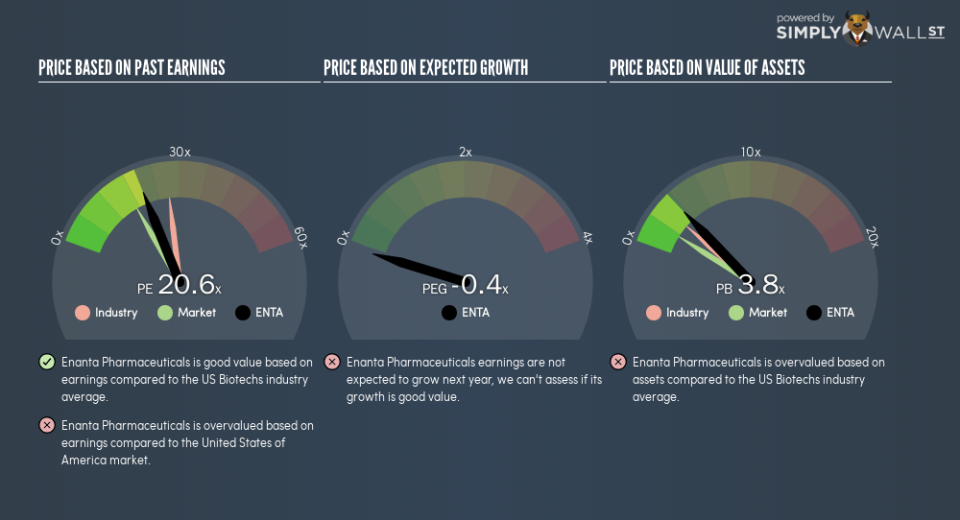Do You Like Enanta Pharmaceuticals, Inc. (NASDAQ:ENTA) At This P/E Ratio?

This article is written for those who want to get better at using price to earnings ratios (P/E ratios). To keep it practical, we’ll show how Enanta Pharmaceuticals, Inc.’s (NASDAQ:ENTA) P/E ratio could help you assess the value on offer. Based on the last twelve months, Enanta Pharmaceuticals’s P/E ratio is 20.58. That means that at current prices, buyers pay $20.58 for every $1 in trailing yearly profits.
Check out our latest analysis for Enanta Pharmaceuticals
Want to help shape the future of investing tools and platforms? Take the survey and be part of one of the most advanced studies of stock market investors to date.
How Do You Calculate A P/E Ratio?
The formula for price to earnings is:
Price to Earnings Ratio = Share Price ÷ Earnings per Share (EPS)
Or for Enanta Pharmaceuticals:
P/E of 20.58 = $76.9 ÷ $3.74 (Based on the year to September 2018.)
Is A High Price-to-Earnings Ratio Good?
A higher P/E ratio means that investors are paying a higher price for each $1 of company earnings. All else being equal, it’s better to pay a low price — but as Warren Buffett said, ‘It’s far better to buy a wonderful company at a fair price than a fair company at a wonderful price.’
How Growth Rates Impact P/E Ratios
Probably the most important factor in determining what P/E a company trades on is the earnings growth. That’s because companies that grow earnings per share quickly will rapidly increase the ‘E’ in the equation. That means unless the share price increases, the P/E will reduce in a few years. So while a stock may look expensive based on past earnings, it could be cheap based on future earnings.
Notably, Enanta Pharmaceuticals grew EPS by a whopping 302% in the last year. And it has bolstered its earnings per share by 9.4% per year over the last five years. I’d therefore be a little surprised if its P/E ratio was not relatively high.
How Does Enanta Pharmaceuticals’s P/E Ratio Compare To Its Peers?
The P/E ratio essentially measures market expectations of a company. We can see in the image below that the average P/E (27.1) for companies in the biotechs industry is higher than Enanta Pharmaceuticals’s P/E.
Enanta Pharmaceuticals’s P/E tells us that market participants think it will not fare as well as its peers in the same industry. Since the market seems unimpressed with Enanta Pharmaceuticals, it’s quite possible it could surprise on the upside. If you consider the stock interesting, further research is recommended. For example, I often monitor director buying and selling.
A Limitation: P/E Ratios Ignore Debt and Cash In The Bank
Don’t forget that the P/E ratio considers market capitalization. That means it doesn’t take debt or cash into account. In theory, a company can lower its future P/E ratio by using cash or debt to invest in growth.
Such expenditure might be good or bad, in the long term, but the point here is that the balance sheet is not reflected by this ratio.
Enanta Pharmaceuticals’s Balance Sheet
Since Enanta Pharmaceuticals holds net cash of US$307m, it can spend on growth, justifying a higher P/E ratio than otherwise.
The Verdict On Enanta Pharmaceuticals’s P/E Ratio
Enanta Pharmaceuticals trades on a P/E ratio of 20.6, which is above the US market average of 17.1. With cash in the bank the company has plenty of growth options — and it is already on the right track. So it is not surprising the market is probably extrapolating recent growth well into the future, reflected in the relatively high P/E ratio.
Investors should be looking to buy stocks that the market is wrong about. People often underestimate remarkable growth — so investors can make money when fast growth is not fully appreciated. So this free visualization of the analyst consensus on future earnings could help you make the right decision about whether to buy, sell, or hold.
Of course you might be able to find a better stock than Enanta Pharmaceuticals. So you may wish to see this free collection of other companies that have grown earnings strongly.
To help readers see past the short term volatility of the financial market, we aim to bring you a long-term focused research analysis purely driven by fundamental data. Note that our analysis does not factor in the latest price-sensitive company announcements.
The author is an independent contributor and at the time of publication had no position in the stocks mentioned. For errors that warrant correction please contact the editor at editorial-team@simplywallst.com.

 Yahoo Finance
Yahoo Finance 
